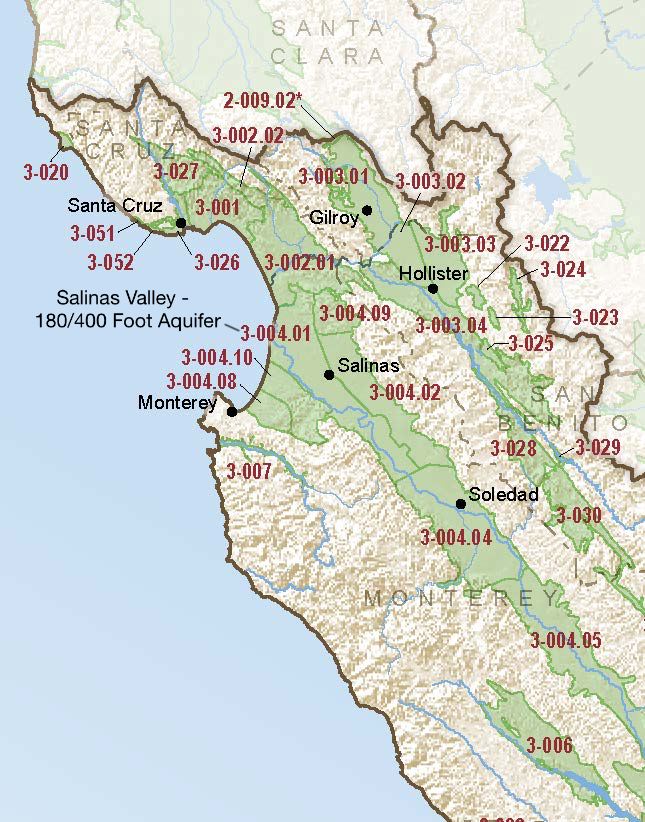Salinas Valley – 180/400 Foot Aquifer
Statistics
- Basin Name
- Salinas Valley – 180/400 Foot Aquifer
- Basin Number
- 3-004.01
- SGMA Basin Priority
- High
- Critically Overdrafted
- Yes
- Hydrologic Region Name
- Central Coast
- Counties
- Monterey
At-A-Glance
Located in California’s Central Coast hydrologic region, the Salinas Valley – 180/400 Foot Aquifer subbasin is 89,706 acres in size. This High priority basin is home to an estimated 57,189 people (2010 value). It has approximately 1135 wells, of which approximately 102 are water supply wells. Groundwater accounts for approximately 100 percent of the basin’s water supply.

Basin Notes
2003: Bulletin 118 basin description
2016: Major basin boundary modifications part of collective changes to the Santa Cruz Purisima formation 3-021, Pajaro Valley 3-002 and Salinas Valley – Langley Area 3-004.09 boundaries. Per 2016 Interim Bulletin 118 update: Various portions of the original Pajaro Valley Basin were moved to three adjacent subbasins/basins—180/400 Foot Aquifer Subbasin (3-004.01), Langley Area Subbasin (3-004.09), and the newly formed Santa Cruz Mid-County (3-001) Basin. A portion of the former Santa Cruz Purisima Formation Basin (3-21) was added to this basin. The Pajaro Valley Basin was also reclassified as a subbasin. A portion of the original 180/400-Foot Aquifer subbasin was moved to the Pajaro Valley Subbasin (3-002.01).
2016: Revised basin boundary description
2018: Basin prioritization comments:
-
- Declining groundwater levels: 1) CASGEM/WDL/GWIDS: Longterm hydrographs show groundwater level decline. Source: DWR 2) “In most of the subareas, were seeing historic lows, said MCWRA senior hydrologist Howard Franklin, adding that he expects new data to show that underground seawater intrusion into the basin, which slowed in recent years, has restarted its march down the valley. – Santa Cruz Sentinel
- Salt intrusion: 1) Seawater intrusion began in the Salinas Valley by the 1930s. Since that time, seawater intrusion has continued and now extends more than five miles inland. The Monterey County Flood Control and Water Conservation District built Nacimiento Dam in 1957 and an Antonio Dam in 1965 to provide flood control and to accelerate groundwater recharge to mitigate seawater intrusion. In April 1998, the Monterey County Water Recycling Projects started delivering recycled water for irrigation in lieu of groundwater pumping, effectively slowing the seawater intrusion rate (MCWRA, 2006). – Central Coast Groundwater: Seawater Intrusion and Other Issues, California Water Foundation, 2014 2) The Salinas Valley Water Project is currently being implemented by the Monterey County Water Resources Agency to mitigate groundwater overdraft and seawater intrusion. The project includes mitigation measures such as construction or retrofit of recharge dams, protection of recharge areas, and injection of recycled water into the impacted aquifers.
2018 Final Basin Prioritization: Basin status is unchanged at High.
2020:
- January 23: Collective GSP from Salinas Valley Basin GSA – 180/400 Foot Aquifer, Salinas Valley Basin GSA – 180/400 Foot Aquifer and County of Monterey GSP filed with DWR
2021: June 3 — GSP approved by DWR
2022: annual reports here
